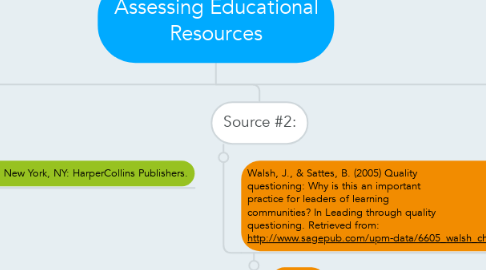
1. Source #1:
1.1. Levitt, S., & Dubner, S. (2014). What does it mean to think like a freak? Think like a freak (pp. 1-17). New York, NY: HarperCollins Publishers.
1.1.1. Currency
1.1.1.1. Written in 2014 and sources cited are also current.
1.1.2. Relevancy
1.1.2.1. Very good source if you are interested in learning to think critically and from multiple perspectives.
1.1.3. Authority
1.1.3.1. Dubner has a Masters of Fine Arts degree from Columbia University. Levitt has a PhD from MIT and has won awards for his contributions in economics. This is the third book from these two authors and both of their previous books are best sellers.
1.1.4. Accuracy
1.1.4.1. The sources they use in the book are quite varied and they have lots of them. They are well organized in a notes page at the end of the book for easy reference. All seems to check out and be credible sources.
1.1.5. Purpose
1.1.5.1. The purpose of this book is to show people how to look at problems through multiple lenses. They are both economists so they tend to lean heavily on data driven answers. The authors want to show people that you can retrain the way you think about almost everything in life.
2. Source #2:
2.1. Walsh, J., & Sattes, B. (2005) Quality questioning: Why is this an important practice for leaders of learning communities? In Leading through quality questioning. Retrieved from: http://www.sagepub.com/upm-data/6605_walsh_ch_1.pdf
2.1.1. Currency
2.1.1.1. Written in 2005, but the information does not require constant updating so is still considered to be current.
2.1.2. Relevancy
2.1.2.1. Great resource for learning to think more critically and using quality questioning to lead your classroom and research.
2.1.3. Authority
2.1.3.1. Both authors are former classroom teachers and have created a nationally accredited professional development on effective questioning. Walsh has a BA in political science from Duke University, a Masters in Teaching from UNC, and a PhD in Education Administration from University of Alabama. Sattes has a BS in psychology from Vanderbilt University and a Masters in early childhood special education from Peabody College.
2.1.4. Accuracy
2.1.4.1. There are many creditable sources cited in a bibliography at the end of the reading. There are also many other books written about this topic and how it can help deepen children's understanding in the classroom.
2.1.5. Purpose
2.1.5.1. The purpose of the book is to teach others to use quality questioning as a way to better our classrooms and encourage thinking from our students. They are also looking to promote their professional development opportunities to schools and administrators.
3. Source #3:
3.1. Azzam, A. M., (2009). Why creativity now? A conversation with sir ken robinson. Educational leadership (67) 1, 22-26. Retrieved from www.ascd.org.
3.1.1. Currency
3.1.1.1. September, 2009 - this still seems to be a current source due to the information on creativity being relevant and that topic doesn't change all that rapidly.
3.1.2. Relevancy
3.1.3. This source is aimed at people in the education field. It is not a source for learning something new but more someone's opinion on what they would like to see more of in schools.
3.1.4. Authority
3.1.4.1. Amy Azzam is a senior associate editor for ASCD, Education Leadership. Sir Ken Robinson is internationally known and respected leader in creativity and education. He is also well know for his TEDtalks and YouTube videos which have gained millions of views.
3.1.5. Accuracy
3.1.5.1. Since this is an interview it is hard for Ken to cite anything besides his own research and articles. Due to this we can't verify a lot of what he says due to lack of data. His reputation does lead us to believe that he is a fairly creditable source.
3.1.6. Purpose
3.1.6.1. The purpose of this interview is to educate people on the importance of creativity in education. They also offer suggestions about ways to connect creativity to other things in life so it can play a role in more than just schools. Ken has done a lot of research in this area and hopes it will inspire others to try it.
